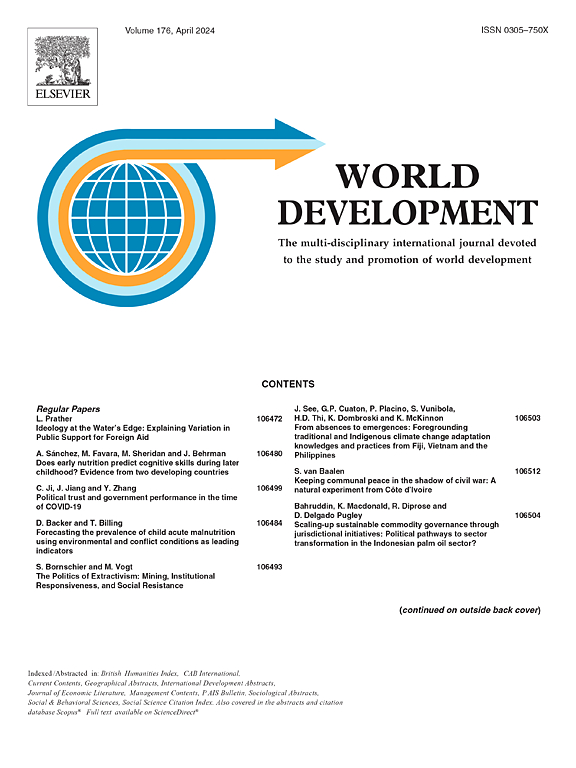发展援助对战后暴力的部门影响:来自大湖区的按空间分类的证据
IF 4.8
1区 经济学
Q1 DEVELOPMENT STUDIES
引用次数: 0
摘要
在20世纪90年代和21世纪初,非洲大湖地区经历了近代史上最具破坏性的冲突。继2000年代中期脆弱的和平谈判之后,国际捐助者拨出380多亿美元发展援助,以支持整个地区的稳定。本研究通过对刚果民主共和国、乌干达和布隆迪的100多个地区和省份进行空间和部门分类分析,评估了这些努力的有效性。为了确保稳健的推断,我将负二项回归与次国家行政单位的粗精确匹配相结合,并对当地定义的缓冲区进行差中差估计。结果表明,发展援助对暴力的影响在很大程度上取决于项目的部门导向。保健和社会保护项目始终与统计上显著减少暴力有关,而刺激基础设施的项目对暴力的发生没有影响。相反,有迹象表明,教育和经济发展项目可能存在问题。引人注目的是,这些发现反映了阿富汗受冲突影响地区的证据,表明发展援助如何在脆弱环境中发挥作用的更广泛模式。这项研究突出了一刀切的发展战略的局限性,并强调了根据受援国的政治、社会和文化背景调整援助的重要性。它为决策者和学者提供了重要的见解,呼吁对冲突后的发展合作采取更加细致入微和对环境敏感的方法。本文章由计算机程序翻译,如有差异,请以英文原文为准。
Sectoral effects of development aid on post-war violence: spatially disaggregated evidence from the Great Lakes region
In the 1990s and early 2000s, Africa’s Great Lakes region experienced some of the most devastating conflicts in recent history. Following a fragile peace negotiated in the mid-2000s, international donors allocated over $38 billion in development aid to support stabilization across the region. This study evaluates the effectiveness of these efforts through a spatially and sectorally disaggregated analysis of over 100 districts and provinces in the Democratic Republic of Congo, Uganda, and Burundi. To ensure robust inference, I employ a combination of negative binomial regression with coarsened exact matching on subnational administrative units and difference-in-differences estimations on locally defined buffer zones.
The results demonstrate that the impact of development aid on violence is highly contingent on the sectoral orientation of the projects. Health and social protection projects are consistently associated with a statistically significant reduction in violence, while infrastructure-stimulating projects do not affect the occurrence of violence. In contrast, there are indications that education and economic-developing projects could be problematic. Strikingly, these findings mirror evidence from conflict-affected settings in Afghanistan, suggesting broader patterns in how development aid works in fragile environments.
This research highlights the limitations of one-size-fits-all development strategies and underscores the importance of tailoring aid to the political, social, and cultural context of recipient communities. It provides important insights for both policymakers and scholars, calling for a more nuanced and context-sensitive approach to post-conflict development cooperation.
求助全文
通过发布文献求助,成功后即可免费获取论文全文。
去求助
来源期刊

World Development
Multiple-
CiteScore
12.70
自引率
5.80%
发文量
320
期刊介绍:
World Development is a multi-disciplinary monthly journal of development studies. It seeks to explore ways of improving standards of living, and the human condition generally, by examining potential solutions to problems such as: poverty, unemployment, malnutrition, disease, lack of shelter, environmental degradation, inadequate scientific and technological resources, trade and payments imbalances, international debt, gender and ethnic discrimination, militarism and civil conflict, and lack of popular participation in economic and political life. Contributions offer constructive ideas and analysis, and highlight the lessons to be learned from the experiences of different nations, societies, and economies.
 求助内容:
求助内容: 应助结果提醒方式:
应助结果提醒方式:


